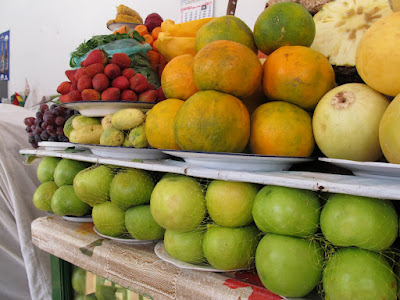
Sucre is arguably Bolivia's most beautiful city. Unarguably, probably, but since I didn't go to them all I'm in no position to argue or not-argue. That said, it was aesthetically pleasing to your hero, with its white colonial buildings, cathedrals and convents.
But it was Sucre's market that I found most beautiful. Unlike most of the markets around the developing world it did not stink, for reasons that I did not ascertain--although it might be due to the fact that it is winter in temperate Sucre right now, and as such, the cuts of meat that hang out all day remain relatively chilled. In many markets of the world the vegetables can look fresh but filthy, generally resting on the pavement that 10,000 motorbikes have just tread. But not in Sucre, lovely Sucre, where the vegetables are piled high above where the feral dogs play.
But the best part about the Sucre market, and the reason that I visited twice a day while I was there, was the juice ladies.

There are at least 10 ladies with juice stands, each completely indistingishable from the next. For an average of $0.40, they will juice just about anything for you. Carrots, mangos, oranges, guanabana, papaya, whatever. Juices can also be served "con leche" which is a polite way of asking for your previously healthy beverage to be turned into a condensed milk concoction more closely resembling a strawberry sundae from Swensen's than a fruit juice. (Rest easy, my concerned pals, I held off.)

The juices are served in a tall ice cream glasses. The best part about the whole operation is that when you are done, you hand the glass back to the juice woman and she says "un poco mas?" and if you nod, she fills the glass up another three-quarters full. Bliss.

And for the less juicily inclinded, they also make a mean fruit salad that can contain any of the following: coconut, fruit-flavored yogurt, saltines, chocolate syrup, puffed rice, whipped cream and, of course, fruit.





















